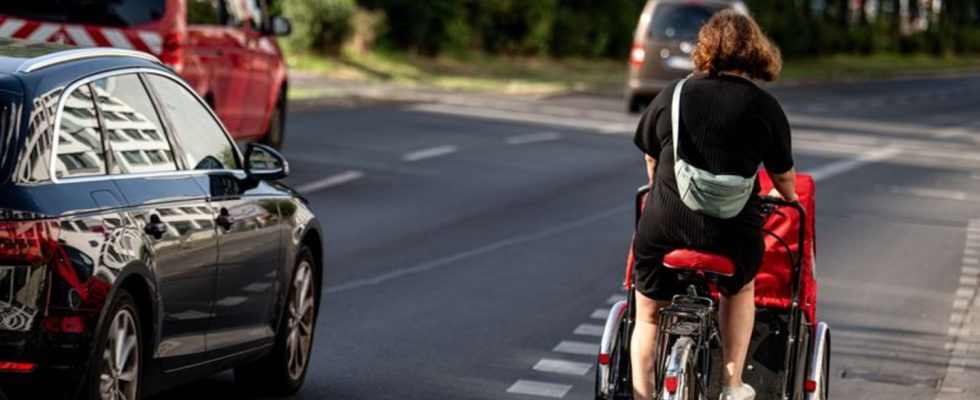Traffic
Fall with a cargo bike: Researchers demand safety for children
A cyclist rides a cargo bike. These are often used to transport children. photo
© Fabian Sommer/dpa
Cargo bikes are very popular with families. But safety when transporting children is often poor, accident researchers complain. They want stricter regulations.
A man is driving quickly with his child Cargo bike, suddenly an orange car pulls onto the road from the right. The cyclist is frightened, tries to swerve to the left and loses control: the heavy bike falls over. The man and the toddler hit the asphalt.
“The consequences would be fatal – both could be seriously injured,” says the insurer’s (UDV) accident research director, Kirstin Zeidler, after the live crash test with dummies at a press event in Münster.
In a multi-year study, the Insurance Research Institute has looked into bicycle accidents involving children – specifically the increasingly popular cargo bikes for taking children with you.
According to an online survey as part of the study, different types of cargo bikes are already used by almost a third of parents to transport children. Sales numbers are increasing. A further increase in the proportion of cargo bikes used to transport children is to be expected in the future, said Zeidler. Because of their comparatively high weight, many of the bikes have electric motors and are therefore relatively fast and even heavier.
Helmet worn too rarely
Cargo bikes in particular with two front wheels, one rear wheel and the transport box in front of the driver are difficult to ride and “highly prone to tipping over,” said Zeidler at the press conference in Münster on Thursday. In the event of an accident, they offer the children no protection for their heads or upper bodies. After the simulated accident, the child dummy lay with its head directly on the asphalt.
The accident researcher recommended stricter safety requirements – such as stable seats with head protection instead of a simple seat board, effective belts and a safety cell as impact protection. A tilting technology for cargo bikes – as already offered by some manufacturers – creates additional stability, she said. Parents should definitely pay attention to such safety features when purchasing.
Parents should also consistently wear a helmet on their children. So far, according to the study, only around half of the children on cargo bikes wear such head protection – probably because of the false feeling of security in the cargo bike box, said Zeidler.
Defects also in trailers and child seats
Cycling accidents involving injured children have so far been rare, but the number is increasing. In 2022, according to police accident statistics, children up to the age of seven were injured in 222 bicycle accidents nationwide, seriously in twelve cases, said head of investigation Matthias Kühn. The value is 45 percent higher than the 2019 value.
For comparison, the accident researchers also examined bicycle trailers and child seats on the luggage rack as alternatives for transporting children. There was criticism here too: children’s trailers were easy to miss and easily turned sideways when braking sharply, Zeidler complained. With child seats on the luggage rack, the height of the fall in the event of an accident and the high center of gravity are problematic. The bike becomes unstable – for example when swerving or stopping.
Here too, the researchers see a need for improvement – such as a separate brake and permanently installed lighting for trailers. The experts also recommend sturdy tripod stands for bicycles with rear child seats or a reduction in the maximum permitted weight for children in the rear child seat from the current 22 to under 20 kilograms.
However, the researchers see the greatest potential for improvement in the cargo bike. “Cargo bikes have some catching up to do – and there are hardly any guidelines yet,” says Zeidler. There are currently no special requirements for cargo bikes in the road traffic regulations; the relevant DIN standard only stipulates a “suitable seat for every child with a belt system”.
The regulatory gap must be closed, demanded Zeidler. The manufacturers would have to go along with it – and parents would also have to use helmets and belts.

